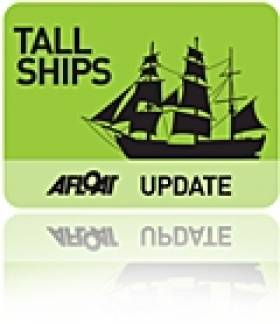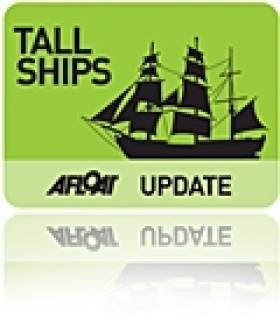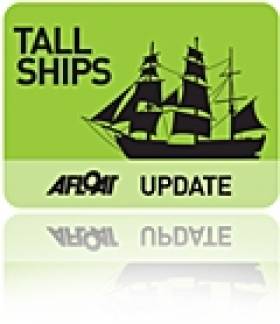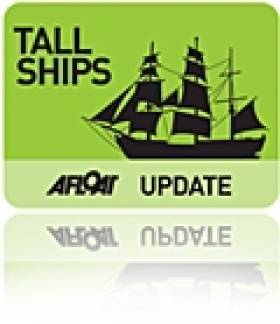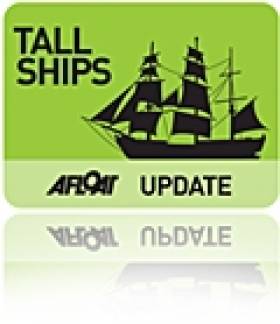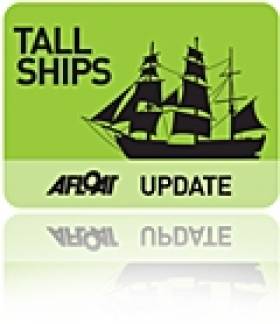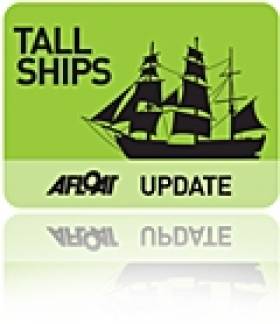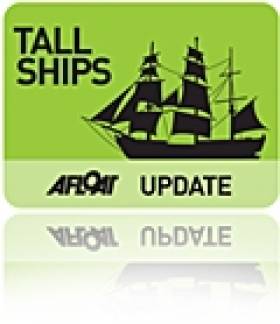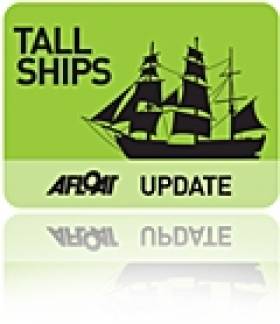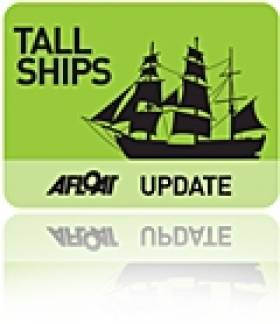Displaying items by tag: Jeanie Johnston
#Jeanies€100kbill – The responsibility of Jeanie Johnston soon to be transferred to Dublin City Council faces annual running costs of some €100,000, reports the Herald.ie
The replica famine ship which was undergoing repairs when previously reported on Afloat.ie is among a list of assets that will be handed over from the Dublin Docklands Development Authority (DDDA) to the council when it eventually winds down.
Currently, the ship costs €240,000-a-year to run but ticket sales do not cover all expenses.
The ship is among some key features in the Docklands which will be transferred to the council.
It is also planned to give a €3m cash sum to the council and extra funds to carry improvements on facilities that are not up to scratch.
However, when asked last night if the Jeanie Johnston's repairs (see photo from another report) would be included in this budgeted improvement, the DDDA did not respond.
For more on the story, click here.
Jeanie Johnston Museum Ship Damaged By Water
#DamagedJeanie – Jeanie Johnston, the replica famine tallship is undergoing repairs for water damage caused by sitting on Dublin's quayside for the last five years, writes The Sunday Times.
The ship, owned by the soon-to-be-defunct Dublin Docklands Development Authority (DDDA), was as previously reported on Afloat.ie dry docked for the first time late last year because of fears about its condition.
The ship, which operates as a museum, currently has scaffolding around its hull as damaged timber is repaired, which Afloat also reported on after she vacated Dublin Graving Docks Ltd last November.
Last week, the DDDA said the ship could not be repaired until now because of a shortage of money. "While regular dry docking is recommended, this was not possible for some years when the authority was in dire financial circumstances," it said. "The authority is currently undertaking a review of the future maintenance requirements. Repairs above the water line are ongoing."
Last week the finance committee of Dublin City Council heard concerns about the future of the Jeanie Johnston once the DDDA is wound up. For much more on this saga, click here.
In addition click close-up photo taken last December shows scaffolding concentrated around her rotting damaged stern quarter.
Radio Documentary Online: The "Dream of Jeanie", Her Return to Sea?
#RadioDocumentary - A Newstalk documentary by radio producer and archaeologist Jane Ruffino looks at the past, present and future of the Jeanie Johnston Tall Ship in "The Dream of Jeanie" which was broadcast this weekend.
The barque, Jeanie Johnston, a 19th replica famine and emigrant museum ship has been part of Dublin’s skyline since 2004, a year after her voyage to the eastern seaboard of the USA and Canada.
She was built at the turn of this century, in Blennerville just outside of Tralee, Co Kerry, a project that took nine years to complete. Originally planned at a cost of £4m, the final cost was nearly €14m, and for a long time, was used as shorthand for poor planning and parochial thinking.
The one-hour radio documentary interviews prominent crew members and those involved in her construction and how the Jeanie came to be in Dublin, plus asks should there more done to get her back to sea?
John O'Neill, manager of Aiseanna Mara Teoranta, which operates the vessel on behalf of owners, Dublin Docklands Development Authority (DDDA) discussed her future which as previously reported on Afloat.ie had undergone a dry-docking maintenance programme last October.
As the Jeanie has not been to sea for some time, there remains further work to do before she is fit to return to sailing, including as also reported, the replacing of timbers at the stern transom.
Despite this work which is been carried out while moored at her usual Liffey city centre berth at Custom House Quay, visitors can still come on board for 50 minute guided tours.
O'Neill added, there’s also the need to have the Jeanie re-certified as an a sea-going vessel which is done under survey with the Department of the Marine.
There is also the issue of scheduling and timing towards bringing her back to sailing again, which O'Neill explained is always their ambition.
In the meantime while running as a museum which has seen increased visitors last year, this has helped to self-fund the vessel in her current role with the aim towards that of a sail-training vessel.
If you missed the ‘The Dream of Jeanie’ which was first broadcast on Newstalk 106-108fm there’s still a chance to hear online with a podcast available by clicking HERE.
Tall Ship Jeanie Johnston Goes Under Further Repair Work
#JeanieJohnston - Almost a month after returning from essential maintenance in a dry-dock, Jeanie Johnston is still undergoing major work this week but now focused at her stern while moored at her customary Dublin city-centre berth, writes Jehan Ashmore.
Afloat.ie has attempted several times to contact the operators managing the 19th century replica famine museum ship as to the reasons for the works.
Despite these related works which started six weeks ago and during that of her dry-docking period, it is understood that the popular tourist attraction remains open as usual. The museum ship has 45–minute guided tours that tell the story of Irish emigrants fleeing the famine to seek a better life in the New World.
As can be seen in the photograph particularly at the poop is where hull timbers have been removed to expose the hull's framework. Having made an inspection from the quayside, it was also noted further exposed hull frames are at the deck below and debris is piled on the pontoon alongside.
Is the original structure is to be replicated or perhaps altered to suit new requirements of the tourist attraction which has been a floating museum for more than a decade?
Jeanie’s Past Leaves in Her Wake 'Back to the Future' Jetfoil
#JeanieJetfoil – Jeanie Johnston, the replica 19th barque famine and emigrant museum ship reopened yesterday for guided tours at her dedicated Custom House Quay berth at Dublin City Moorings, writes Jehan Ashmore.
A month ago today the Dublin Docklands Development Authority owned barque departed her berth for a night-time tow that led eventually to entering a dry-dock downriver for essential maintenance. Now that the spruced-up replica of the original built in Canada in 1847 has returned, visitors can hear the story of how Irish emigrants fled the famine to seek a better life in the New World.
Along this same stretch of Liffey quayside is where in complete contrast the B+I Line (est. 1836 and state owned since 1965) launched a pioneering and bold 'Jet-Foil' operated fast-ferry service to Liverpool in 1980.
The Boeing built 257 passenger-only Jet-Foil craft Cu Na Mara (click PHOTO) connected the city-to-city crossing in only 3 hours. The Jet-Foil made daily daylight sailings in both directions.
Cu Na Mara meaning 'Hound of the Sea' set a record on the 126 nautical mile route with a time of 2 hours 50 minutes. The service only lasted for two years though it is understood the craft still operates in Japanese waters.
Unlike the Jeanie Johnston (including the replica) which crossed the Atlantic Ocean, the Cu Na Mara was transferred from the Boeing facility in Seattle on the U.S. west (Pacific) coast and loaded onto containership Antonia Johnston for a delivery voyage to Dublin Port.
As previously reported, a B+I Line reunion next Saturday 15 November for crew and shore personnel is to be held in the Clifton Court Hotel, Eden Quay, Dublin. For information contact Noel Byrne 086 3130697, by email: [email protected] or Morris Ward on 087 7409249
The 'Jeanie' Returns to Liffey Quays to Reopen Tomorrow
#JeanieReturns – Replica 19th century barque Jeanie Johnston has finally returned to her dedicated Dublin Liffey berth along Custom House Quay having had some delays following essential maintenance in a drydock, writes Jehan Ashmore.
The good news is that guided tours of the famine emigrant museum tallship will reopen from 1100 am tomorrow (Friday 7 November). For further information click HERE.
In recent days the barque has been undergoing finishing touches while at a temporary lay-by berth close to the East Link Bridge.
Beforehand the Tralee registered replica had been dry-docked for essential maintenance having entered the Dublin Graving Docks Ltd facility almost a month ago. The shiprepair and conversion business faces closure due to plans to redevelop Alexandra Basin by Dublin Port Company.
The work on the barque was her third and also the most extensive carried out in the shiprepair and conversion facility since her purchase more than a decade ago by the Dublin Docklands Development Authority (DDDA).
Sister tugs Beaufort and Shackleton from Dublin Port Company repeated the exercise of returning the Jeanie Johnston to her city-centre berth at Dublin City Moorings. This involved a short tow upriver having transited through the East-Link toll lift-bridge and the Samuel Beckett swing bridge.
The pontoon facility at Custom House Quay was installed by the DDDA as part of a river Liffey rejuvenation project to attract visiting yachts. In addition to generating waterborne activity in an attempt to emulate other European capitals which have a vibrant river or waterfront setting.
Jeanie Johnston Tours 'Not' Open Due to Continued Essential Maintenance
#JeanieNotOpen – According to the Jeanie Johnston website, tours of the replica 19th barque are 'not' available at present, it transpires that essential maintenance is still been carried out on board.
The announcement (click HERE) from the operators of the visitor attraction continued to read that they expect to reopen soon, however they ask that those wishing to seek up to date details regarding availability should email them.
The email is [email protected], for further general information about the replica famine emigrant ship that sailed to the New World, click to the above 'announcement' link.
As previously reported, Jeanie Johnston departed Dublin Graving Dock on Thursday, having undergone an overhaul and that she was due to reopen today.
The Tralee registered barque currently remains moored alongside a berth close to the East-Link Bridge. When work is completed she will make the short journey upriver to her designated berth at Custom House Quay.
#JeanieJohnston - Jeanie Johnston departed Dublin Graving Docks today following the replica 19th barque's most extensive maintenance work since her purchase by the DDDA more than a decade ago, writes Jehan Ashmore.
She is scheduled to resume her famine emigrant museum ship role with tours starting this Saturday (1 November).
Among the work carried out by the dockyard which faces closure as previously reported, was cleaning of her hull, removal of debris notably along the waterline and timber replaced where necessary in addition to repainting.
Graving Dock No.2 was flooded to allow the replica tallship to vacate from the Alexandra Basin based ship-repair facility with tug assistance to her current lay by berth next to the East-Link Bridge.
She will then continue her final short leg upriver with a transit also involving the opening of the Samuel Beckett swing –bridge to moor along her usual Custom House Quay berth.
The visitor attraction which had 20,000 visitors to date this year, tells the story of the famine and the emigrant carrying barque whuch sailed to the New World. Between 1848-1855 she carried more than 2,500 people from Ireland on 16 crossings to North America.
A bonus for the museum ship has been a rise in Canadian tourists due to more flight capacity. They are drawn to the museum ship as the original Jeanie Johnston was built in Quebec in 1847 along the St. Lawrence River.
#JeanieJohnston - Jeanie Johnston which is undergoing maintenance at Dublin Graving Docks Ltd was joined this week by Dutch flagged Arklow Rambler at the ship-repair facility that faces closure by Dublin Port Company over plans to redevelop Alexandra Basin, writes Jehan Ashmore.
As previously reported, Dublin Graving Docks which employs around 26 people at a site within the port estate area of Alexandra Basin is where DPC propose a €200m project to accommodate much bigger cruise ships at a dedicated terminal as outlined at a recent planning hearing by An Bord Pleanála.
Dublin Graving Docks which operates the port-owned 200m long graving dock is the only ship-repairer and conversion business left remaining in the country's largest port.
However the Alexandra Basin Redevelopment (ABR) project (see website) for cruise berths would also involve a reconfiguration of other berths throughout the basin. In addition the plans are to enable larger deep-drafted cargoships and more quayside space to include the site of the dry dock.
Currently trade throughput is around 29 million tonnes though the port's strategy is to plan ahead so to handle 40 million tonnes by 2040. This is where the ABR forms phase one of the Dublin Port Company's Masterplan (2012-2040) which sets out the future of the port over the next four decades.
Jeanie Johnston is a replica 19th century barque based on the original built in Quebec Canada in 1847 that transported 2,500 people to North America. Since her acquisition by Dublin Docklands Development Authority (DDDA) in 2005, she has been dry-docked twice at the nearby facility.
The DDDA brought the Tralee registered tallship as part of a river regeneration project and appointed Aiseanna Mara Teoranta on their behalf to operate the vessel as a tourist attraction.
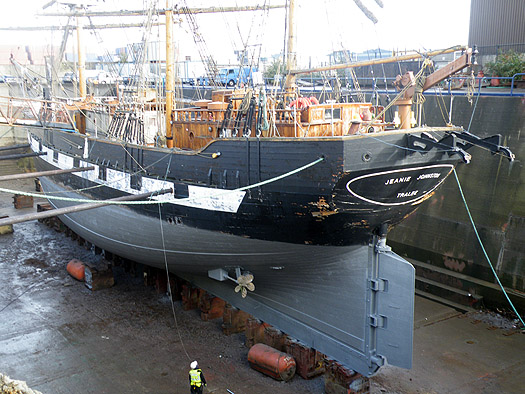
Jeanie Johnston, the replica 19th century barque is undergoing her most extensive maintenance dry-docking since DDDA's purchase in 2002. She is seen as a fresh layer of primer paint is applied to her timber hull. Photo Jehan Ashmore
Last year she welcomed 20,000 visitors and this year there has been a rise in Canadian tourists due to more flights to Ireland, in which they have heard the story on board of how Irish emigrants fled the famine and sought a better life in the New World.
As she lays in Graving Dock No.2, this is a far removed environment to her role at her berth close to the Convention Centre.
Her maintenance programme requires intensive cleaning of her hull, removal of debris notably along the waterline and any replacement of timber plus applying layers of paint. On completion of the work she is to return shipshape and resume her museum role on 1 November.
#JeanieJohnston - The replica 19th barque Jeanie Johnston departed her role as a static famine emigrant museum ship along Dublin's Custom House Quay, as she is to undergo 'essential maintenance', writes Jehan Ashmore.
Jeanie Johnston's short tow downriver was carried out by Dublin Port Company tug sisters, Beaufort and Shackleton, which involved transiting through two bridges, firstly the Samuel Beckett swing-bridge and then the East-Link toll-lift bridge.
The three masted vessel temporally moored alongside the North Quay Wall Extension next to the East-Link where the tugs are stationed. As of this morning she berthed alongside the lead-in jetty of Dublin Graving Docks Ltd's facility within Alexandra Basin. Again this operation involved the pair of tugs in which the Shackleton had only recently vacated the same graving dock.
Due to the dry-docking, tours of the replica tallship will not be available from today, however they are due to resume on 22 October. The 50 minute tours tell the story of how Irish emigrants during the famine departed these shores in the hope of survival and seeking a future in the 'New World'.
The original Jeanie Johnston was built in Quebec, Canada in 1847. She carried more than 2,500 people from Ireland on 16 crossings to North America between 1848 to 1855.
As for the replica, she became the floating museum following a short-lived career 'sailing' around Irish ports and several trips to Spain. Her high-point was the 'reinactment' voyage from Tralee to North America in 2003 with calls to U.S. and Canada.
In 2005, she took part in the Tall Ships Races from Waterford and in that same year she was brought by the Dublin Docklands Development Authority to become her present role as a city-centre tourist attraction.
At the time of her sale by Tralee Town Council and Kerry County Council, there were fears that the barque built in Tralee, Co. Kerry, amid controversial circumstances and cost overruns would be sold abroad and never to return.
Following the sinking of the state owned STV Asgard II in 2008, there were calls for Jeanie Johnston to be reactivated as a sail training vessel to replace the brigantine lost off Brittany.




























